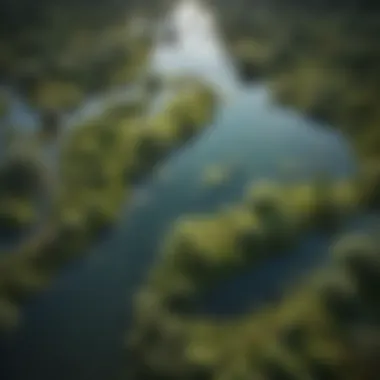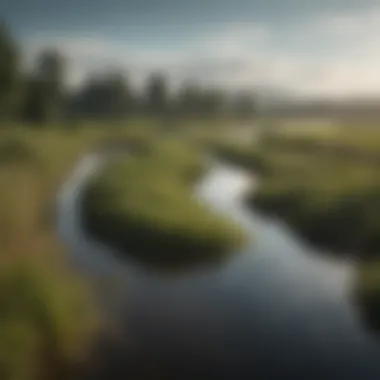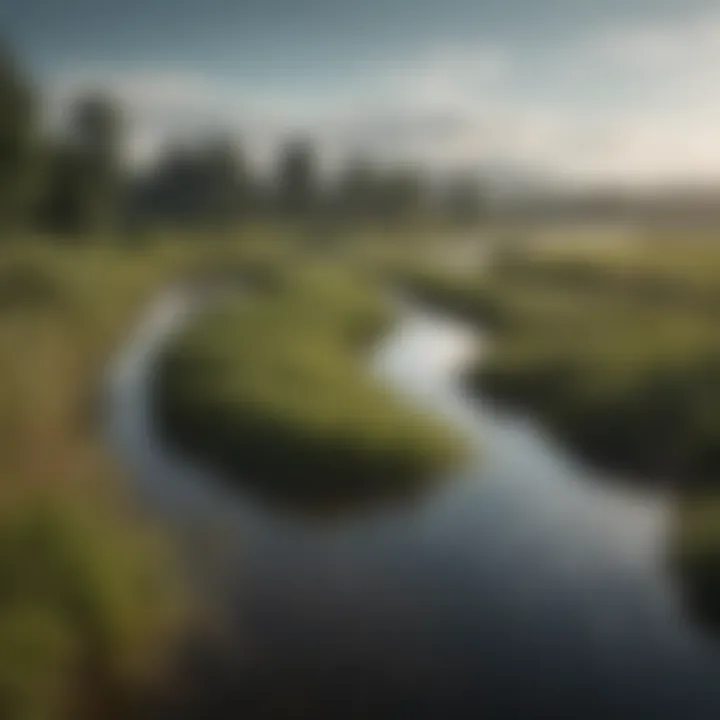Planting Wetlands: Insights on Benefits and Methods


Overview of Research Topic
Brief Background and Context
Wetlands serve as vital ecosystems that provide a range of ecological, hydrological, and socio-economic benefits. These areas are characterized by saturated soil, standing water, and a unique assemblage of flora and fauna. Various types of wetlands, including marshes, swamps, and bogs, exist, each playing a specific role in the environment. In recent years, there has been a growing recognition of the importance of wetland restoration and creation, largely due to the rapid urbanization and agricultural expansion that have led to wetland degradation.
Importance in Current Scientific Landscape
In the context of climate change and increasing environmental pressures, the restoration of wetlands has gained significant attention. Scientists and policymakers are exploring how the sustainable management of these ecosystems can aid in carbon sequestration, floodwater management, and biodiversity conservation. By delving into the methodologies for planting wetlands, this article provides insight into how such initiatives can contribute to environmental stability and resilience.
Methodology
Research Design and Approach
The examination of wetland planting involves both theoretical underpinnings and practical applications. This article takes a comprehensive approach, reviewing existing literature, case studies, and empirical research to provide a robust understanding of the process. The research emphasizes interdisciplinary perspectives, considering ecological, hydrological, and socio-economic factors that influence wetland planting efforts.
Data Collection Techniques
Data collection is essential for understanding the outcomes of wetland restoration projects. Employing various techniques, such as field surveys, remote sensing, and hydrological modeling, researchers can gather vital information about wetland health and ecosystem services. Data from sources like the U.S. Environmental Protection Agency and state environmental agencies is frequently analyzed to cross-reference findings and develop actionable guidelines for effective wetland planting.
With this foundational understanding, the article proceeds to define the practical guidelines for planting wetlands, addressing the steps necessary for successful implementation.
Prolusion to Wetlands
Wetlands are crucial ecosystems that play a significant role in maintaining environmental balances. This article emphasizes the importance of wetlands, particularly in the context of restoration and planting initiatives. Understanding wetlands entails more than just recognizing them as bodies of water; they serve various ecological functions and offer numerous benefits to surrounding environments and communities.
Definition and Types of Wetlands
Wetlands are defined as areas where water covers the soil or is present near the surface for part of the year. This presence of water leads to unique soil types and a distinct plant life adapted to wet conditions. There are several types of wetlands, including:
- Marshes: Dominated by herbaceous plants, marshes can be fresh or saline.
- Swamps: These wetlands are characterized by the presence of trees and shrubs. They typically have higher nutrient levels compared to other wetland types.
- Bogs: Acidic wetlands that accumulate peat and often support specialized plant species like sphagnum moss.
- Fens: Similar to bogs but are less acidic and receive groundwater seepage, providing nutrient-rich conditions for plant growth.
Each wetland type contributes differently to ecosystem functions and requires specific considerations when planting.
Importance of Wetlands in Ecosystems
Wetlands are vital for several reasons. They act as natural sponges, absorbing excess rainwater and reducing flood risks. Their ability to filter pollutants improves water quality in adjacent bodies of water.
Wetlands also provide habitat for a diverse range of species, including fish, birds, and invertebrates. The rich biodiversity supported by wetlands fosters healthy ecosystems. Moreover, they sequester carbon, aiding in the fight against climate change.
"Wetlands are the kidneys of the landscape, filtering out pollutants and providing critical habitats for wildlife."
In summary, understanding the definition and importance of wetlands is foundational when discussing wetland planting processes. Acknowledging their ecological roles can lead to more informed approaches in conservation and restoration efforts.
Ecological Functions of Wetlands
Wetlands serve a profound role in ecological systems. Their functions extend beyond mere aesthetics or recreation; they are vital for various biological and hydrological processes. Understanding these functions can guide successful wetland planting and restoration initiatives. Let’s examine the specific ecological benefits wetlands provide.
Habitat Provision
Wetlands are rich ecosystems that provide diverse habitats for a multitude of species. They support a variety of plants, insects, amphibians, reptiles, birds, and mammals. This biodiversity is crucial for maintaining ecological balance.
- Biodiversity Hotspots: Wetlands host unique flora and fauna, some of which are not found in any other ecosystem. For example, many migratory birds make use of wetlands as critical feeding or nesting grounds.
- Food Web Support: The plant and animal life in wetlands form a complex food web. Vegetation such as cattails and sedges provides food and shelter for numerous species, promoting a rich biodiversity.
- Endangered Species: Many endangered species rely on wetlands for their survival. Protecting these ecosystems is essential for conservation efforts.
In short, the role of wetlands as habitats cannot be overstated; they enhance biodiversity, support endangered species, and contribute significantly to ecosystem stability.


Water Filtration and Quality Improvement
Wetlands are natural water filters, playing a crucial role in enhancing water quality. They remove pollutants and sediments before water enters larger water bodies, thus impacting whole watersheds.
- Nutrient Cycling: The plants in wetlands absorb excess nutrients like nitrogen and phosphorus. This process not only improves water quality but also reduces the likelihood of eutrophication.
- Sediment Trapping: Wetland soils are effective at trapping sediments running off from surrounding areas. This helps in maintaining clearer water in rivers and lakes, essential for fish and other aquatic life.
- Pollutant Breakdown: Bacteria and microorganisms in wetland soils break down toxic substances, contributing to a healthier ecosystem.
By promoting cleaner water, wetlands facilitate the health of aquatic environments and the wellbeing of organisms that depend on these waters.
Flood Mitigation
Wetlands are essential for managing flood risks in their surroundings. Their natural capacity to retain and slowly release water acts as a buffer against flooding.
- Water Absorption: Wetlands can store large amounts of water during heavy rains or snowmelt, reducing peak flow in rivers and preventing downstream flooding.
- Slow Release: The densely packed vegetation and soil structure of wetlands allow them to release water slowly, ensuring that surrounding areas experience less abrupt flooding.
- Ecosystem Resilience: By mitigating floods, wetlands protect not just aquatic life but also protect human settlements, agriculture, and infrastructure.
Through these functions, wetlands play a critical role in flood management, ultimately protecting and preserving human communities as well.
"Wetlands provide essential ecological functions that contribute to ecosystem health and resilience. Their preservation and restoration are crucial for ecological integrity."
Methods of Planting Wetlands
The act of planting wetlands is a nuanced process requiring careful planning and consideration. The methods chosen can significantly influence the success of wetland establishment and its long-term viability. In this section, we will examine crucial aspects such as site selection and preparation, the ideal plant species for wetland areas, and the techniques employed during planting and establishment. These components are vital for ensuring that restoration efforts yield maximum ecological, hydrological, and socio-economic benefits.
Site Selection and Preparation
Selecting the right site for wetland planting is paramount. An ideal location must have specific characteristics, such as soil type, existing hydrology, and surrounding land use. Sites that are naturally wet or have been previously identified as wetlands are often preferable.
- Hydrology Assessment: Evaluate the availability of water sources. This involves analyzing surface and groundwater inputs that can sustain the wetland.
- Soil Testing: Conduct soil tests to determine its composition and pH. Some plants thrive in acidic or alkaline soils, making this analysis critical.
- Surrounding Environment: Consider potential impacts from adjacent land use, such as agriculture or urban development. These can introduce pollutants that affect wetland health.
Preparing the site involves physical alterations, such as removing invasive species and managing excess debris. These preparatory steps create a more conducive environment for planting and establish a better chance for the plants to establish roots effectively.
Ideal Plant Species for Wetland Areas
Choosing the appropriate plant species is essential for the ecological function of a created wetland. Selecting native species is often recommended, as they are better adapted to local conditions and support local wildlife.
- Common Species: Some well-suited native plants include Typha angustifolia (narrow-leaved cattail), Schoenoplectus acutus (bulrush), and Carex species (sedges).
- Diversity Considerations: It's important to plant a diverse range of species. This diversity enhances habitat complexity and resilience.
- Growth Characteristics: Understanding the growth habits of species is important. Some plants may spread aggressively, while others serve as stabilizers in wetlands.
Techniques for Planting and Establishment
The techniques used in planting wetland vegetation can vary, yet focus on ensuring the successful establishment of plants in the adapted environment.
- Direct Seeding: This method involves sowing seeds directly into the soil or water of the wetland. It’s a low-cost option, yet often yields variable results due to water fluctuations or competition with existing flora.
- Planting Plug or Containerized Plants: Using small pre-grown plants helps ensure a higher survival rate, as established root systems can better withstand environmental stressors.
- Hydroponic Techniques: In some cases, hydro seeding is employed where a mixture of seeds, mulch, and water is applied to the site. This is especially useful in areas prone to erosion.
By employing these methods carefully, the likelihood of wetland restoration success increases. Effective planting not only enhances plant establishment but also solidifies the wetland's ecological benefits over time.
"Properly executed wetland planting methods can lead to significant ecological gains, making the area a biodiverse habitat and improving water quality."
Hydrological Considerations in Wetland Planting
Hydrology plays a crucial role in the success of wetland planting projects. Understanding water dynamics is essential as it influences plant growth, soil composition, and the overall health of the ecosystem. Hydrological considerations ensure that the wetland can serve its intended ecological functions while also providing benefits to surrounding communities.
Water Sources and Management
Water sources for wetlands can vary significantly. They may receive water from rainfall, surface runoff, or groundwater depending on the location and the environmental context. To effectively manage these sources requires careful planning. A consistent water supply is vital for the survival of planted species. Furthermore, water management strategies must align with the natural hydrological cycles of the area. This includes:
- Assessing Local Hydrology: It is crucial to understand historical water patterns that influence local wetland systems. This data can showcase which native plants will thrive in specific wet conditions.
- Creating Water Control Structures: Dams and pumps can help maintain desired water levels, especially in areas prone to drought or flooding.
- Monitoring Water Quality: Regular testing ensures that nutrients and contaminants remain at optimal levels to support a thriving ecosystem.
By focusing on water sources and management strategies, wetland projects can maintain the proper conditions needed for flora and fauna to prosper. This not only benefits the environment but also serves community needs for clean water and flood protection.


Soil Types and Their Influence
The type of soil present influences the selection of plant species and the success of wetland restoration efforts. Different soils have various properties, such as nutrient content, moisture retention, and drainage capability. Here are some considerations regarding soil types in wetland planting:
- Hydric Soils: These are soils formed under conditions of saturation, flooding, or ponding. They usually indicate water availability and influence the type of vegetation that can be supported. Understanding the characteristics of hydric soils is crucial for selecting appropriate species for planting.
- Soil Tests: Conducting soil tests reveals pH levels, nutrient availability, and organic matter content. Such analysis helps in deciding what amendments might be necessary to foster a robust wetland environment.
- Compaction and Aeration: Compacted soils can restrict water flow and root growth, which leads to poor plant establishment. Introducing best management practices like soil aeration can improve soil health and improve the growth of wetland plants.
Understanding the interplay between water and soil types is integral for successful wetland planting. Without this knowledge, restoration projects may fail to thrive and achieve their ecological goals.
"The integration of hydrological and soil considerations is not merely beneficial but essential for the success of wetland restoration endeavors."
In summary, hydrological considerations are central to any wetland planting initiative. They support proper management of water resources and help determine soil suitability for plant species. By addressing these elements, the likelihood of a successful wetland restoration increases, contributing to the ecological balance and sustainability of the region.
Socio-Economic Impacts of Wetland Restoration
Wetland restoration carries significant socio-economic implications that extend beyond environmental benefits. Understanding these impacts is crucial for fostering community support and securing funding for projects.
By restoring wetlands, communities can unlock various opportunities, including enhancing local economies and improving public health. Moreover, wetlands provide essential ecosystem services that can be translated into economic gains.
Community Engagement and Education
Community engagement is vital in restoring wetlands. Actively involving local residents ensures that projects reflect their needs and leverages local knowledge. Initiating educational programs can foster awareness of wetland importance, featuring activities like workshops and field trips. These educational initiatives not only build support but also instill a sense of stewardship among community members.
Often, partnerships between schools, local governments, and environmental organizations yield fruitful outcomes. Notable community examples can include the reintroduction of traditional land-use practices that promote sustainability. Further, local involvement fosters transparency and accountability in conservation efforts.
"Effective community engagement transforms conservation initiatives into collective actions that benefit both people and nature."
Economic Benefits from Ecosystem Services
Wetlands provide numerous ecosystem services highly valued in economic terms. These include water purification, flood protection, and carbon sequestration.
- Water Purification: Wetlands act as natural filters, improving water quality and reducing the costs associated with treating supply for municipalities.
- Flood Protection: By absorbing excess rainfall, wetlands mitigate flood risk, protecting property and infrastructure. This can reduce insurance costs and emergency response requirements.
- Carbon Sequestration: Wetlands store substantial amounts of carbon dioxide. This contributes to climate change mitigation, which can affect various sectors economically in the long run.
When measuring benefits, the ability of wetlands to support biodiversity cannot be overlooked. Increased biodiversity can lead to sustainable tourism opportunities, adding a revenue stream for local economies.
In summary, the socio-economic impacts of wetland restoration are far-reaching. Heightening community engagement and recognizing the economic value of wetlands cultivate support for these projects, ensuring they thrive and continue providing intrinsic and extrinsic benefits.
Challenges in Planting and Maintaining Wetlands
Planting and maintaining wetlands involves numerous challenges that need to be addressed for successful restoration. Understanding these obstacles is vital for those engaged in wetland projects. The complexity of wetland ecosystems demands careful planning and management. This section will explore two significant challenges: invasive species and climate change adaptation.
Invasive Species Management
Invasive species pose a serious threat to wetland habitats. They often outperform native plant species, disrupting the ecosystem balance. Once established, invasive plants can spread rapidly. This makes eradication efforts increasingly difficult. Managing these species requires diligent monitoring and action.
Some effective strategies include:
- Early Identification: Recognizing invasive species early can prevent them from taking hold.
- Mechanical Removal: This includes cutting, pulling, or digging up invasive plants before they seed.
- Chemical Controls: Herbicides may be necessary in some cases, but should be used carefully to minimize impact on native species.
- Restoration of Native Species: Planting native vegetation can help to outcompete the invasives and restore ecosystem functions.
Implementing these approaches successfully requires collaboration among stakeholders. Community participation can be beneficial in educating the public and fostering ongoing stewardship.
Climate Change Adaptation
Climate change presents another significant challenge to wetland planting efforts. Increasing temperatures, altered precipitation patterns, and rising sea levels complicate the establishment of stable wetland ecosystems. Wetlands are often dynamic environments. They need to adapt to changing climatic conditions to maintain their ecological roles.
Effective climate change adaptation strategies are essential:
- Site Selection: Choosing locations that are less vulnerable to climate impacts can enhance the resilience of planted wetlands.
- Flexible Design: Wetland designs should incorporate features that allow for adaptability and response to changing environmental conditions.
- Monitoring and Research: Ongoing research into climate impacts can guide adaptation strategies and improve future projects.


"Sustainable wetland management not only conserves biodiversity but also provides essential services in a changing climate.”
By addressing these challenges, practitioners can enhance the likelihood of successful wetland establishment and maintenance. This proactive approach will ensure that wetlands fulfill their intended ecological and societal functions.
Case Studies of Successful Wetland Projects
Case studies serve as valuable resources in understanding the practical aspects of wetland restoration. They provide real-world examples of the challenges faced and solutions implemented throughout various projects. These examples highlight the importance of thorough planning, community involvement, and adaptive management in achieving positive outcomes. Analyzing successful initiatives allows us to glean insights that can be applied to future projects, filling gaps in knowledge and experience.
Local and Regional Initiatives
Local and regional wetland restoration projects have gained traction over the past decades. Each initiative often reflects unique geographical and ecological contexts while adhering to common restoration principles. In the United States, for instance, the Chesapeake Bay Program has emphasized wetland restoration since the 1980s. This collaboration between state and federal agencies focuses on restoring natural habitats to improve water quality. The result is a network of restored wetlands that enhance biodiversity and reduce nutrient loading into the Bay.
Another significant example is the Everglades restoration project in Florida. Spanning more than 2 million acres, this initiative aims to restore the natural flow of water through the ecosystem. Here, stakeholders have witnessed improvements in water quality and wildlife abundance since the restoration efforts began. Each of these projects illuminates how local concerns can lead to substantial environmental benefits when engaging various community members.
Lessons Learned from Various Projects
Examining different wetland projects makes it possible to identify key lessons that improve future endeavors. One critical insight involves the significance of involving local communities from the inception. Many successful projects, like the Kankakee Sands project in Indiana, have incorporated community engagement, fostering a sense of ownership among residents. Such participation fuels sustained interest in ongoing maintenance efforts, which can be crucial for preserving wetland health over time.
Another lesson is the need for flexibility in restoration approaches. Adapting techniques based on site-specific conditions and emerging challenges has proven effective. For instance, the Packard Wetland in Alaska underwent adjustments in planting techniques due to harsh climatic conditions. Ultimately, the emphasis on resilience in restoration techniques significantly bolsters project durability, showcasing that adjustments are an inherent part of ecological management.
In summary, case studies not only illuminate successful initiatives but also unravel important factors that influence successful wetland restoration. They serve as a foundation for future planning and community collaboration. Analyzing these narratives ensures that progress in wetland conservation continues to address both ecological and socio-economic aspects effectively.
Future Directions in Wetland Conservation
Wetland conservation is increasingly recognized as a critical strategy for environmental sustainability. As pressures from urban development, agriculture, and climate change continue to threaten these ecosystems, future directions in wetland conservation must be both innovative and comprehensive. This section addresses important updates and considerations in wetland conservation, focusing on modern restoration techniques and the necessary policy frameworks. By investing in these directions, we create resilient wetland systems for future generations.
Innovations in Restoration Techniques
The field of wetland restoration is evolving rapidly, driven by advancements in science and technology. Various innovative techniques are being developed and applied to enhance the effectiveness of wetland restoration efforts.
- Use of Drones: Drones are being utilized for mapping and monitoring wetland areas. They provide high-resolution imagery that can help assess vegetation health, water levels, and the overall condition of wetlands.
- Bioremediation: This technique, which employs living organisms to remove or neutralize contaminants, is becoming a practical approach in restoring wetland health.
- Hydrological Modeling: Using advanced modeling tools, hydrologists can better understand how water moves through wetland systems and make informed decisions on restoration methods that optimize water retention and habitat creation.
- Native Plant Restoration: Focus on using native plant species has proven effective in establishing biodiverse and resilient wetland ecosystems. These plants not only thrive better but also provide vital habitat for local wildlife.
"Innovative restoration techniques can dramatically shift the effectiveness of wetland conservation efforts."
Each of these innovations contributes to better outcomes in restoration efforts while strict monitoring remains essential to ensure the longevity of these projects.
Policy Frameworks Supporting Wetland Conservation
Effective policies are crucial for supporting wetland conservation initiatives. It is essential that existing legislative frameworks be updated to reflect current ecological knowledge and the latest scientific findings. Key elements of policy frameworks include:
- Incentives for Preservation: Governments can create financial incentives for landowners to preserve or restore wetlands on their property. This might involve tax breaks or grants for conservation purposes.
- Protection Laws: Implementing or updating regulations that limit development in sensitive wetland areas can help safeguard these ecosystems from destruction.
- Community Involvement: Policies must prioritize community engagement, ensuring that local voices are heard in conservation efforts. Involving communities can foster stewardship and lead to more sustainable outcomes.
- Monitoring and Compliance: Establishing strong systems for monitoring wetland health and compliance with environmental standards ensures that restoration and preservation efforts are maintained over time.
By prioritizing these elements within policy frameworks, stakeholders can enhance protection and management of wetlands effectively. Every effort to improve policies will contribute to a brighter future for wetland ecosystems.
In summary, as we move forward, it is clear that innovative restoration techniques paired with solid policy frameworks are essential components for the successful conservation of wetlands. This will require collaboration among scientists, policymakers, and local communities to achieve resilient and healthy wetland landscapes.
End
The conclusion of this article emphasizes the significant role wetlands play in our environment and society. Wetlands are complex ecosystems that provide a wide array of benefits which are crucial for both ecological health and human needs. Understanding the importance of wetlands is essential as we face increasing environmental challenges, such as climate change and loss of biodiversity.
Summarizing the Importance of Wetlands
Wetlands serve a multi-faceted role in our ecosystems. They provide habitat for numerous species, both flora and fauna, promoting biodiversity. Wetlands also act as natural water filtration systems, improving water quality by trapping pollutants and sediments. This function is invaluable, as it directly impacts the health of downstream ecosystems and human communities relying on clean water. Furthermore, wetlands are effective in mitigating floods by absorbing excess rainfall, which helps protect both wildlife and urban areas.
In addition to ecological functions, wetlands offer substantial socio-economic benefits. They often support agriculture, fisheries, and recreational activities, contributing to local economies. The carbon sequestration capacity of wetlands is another critical aspect, helping to combat climate change. Overall, the value of wetlands transcends ecological boundaries, making their conservation and restoration a priority in environmental management.
Call to Action for Stakeholders
Stakeholders, including government agencies, local communities, NGOs, and businesses, must take action to protect and restore wetlands. Collaborative efforts are necessary to design and implement effective wetland management strategies. Awareness campaigns can inform the public about the importance of wetlands and encourage community involvement in conservation activities.
It's critical to develop policy frameworks that promote sustainable practices within wetland environments. This includes enforcing regulations on land development and pollutant discharge. Funding for restoration projects should be prioritized, enabling communities to engage in meaningful wetland conservation initiatives.
"Wetlands are not just nature’s kidneys; they are vital components of the health of our ecosystem and economy. Acting now is essential to ensure these ecosystems thrive for future generations."



